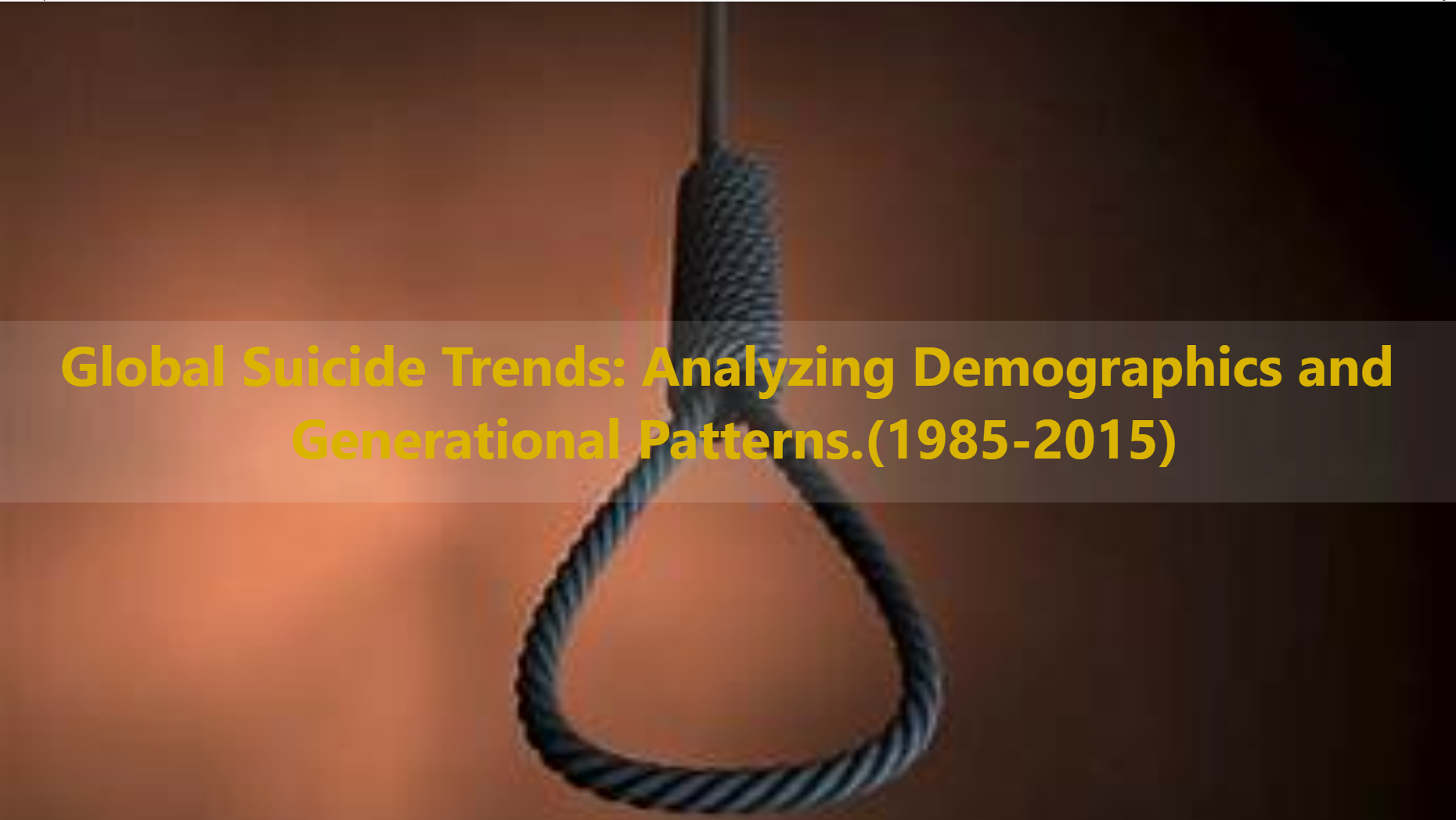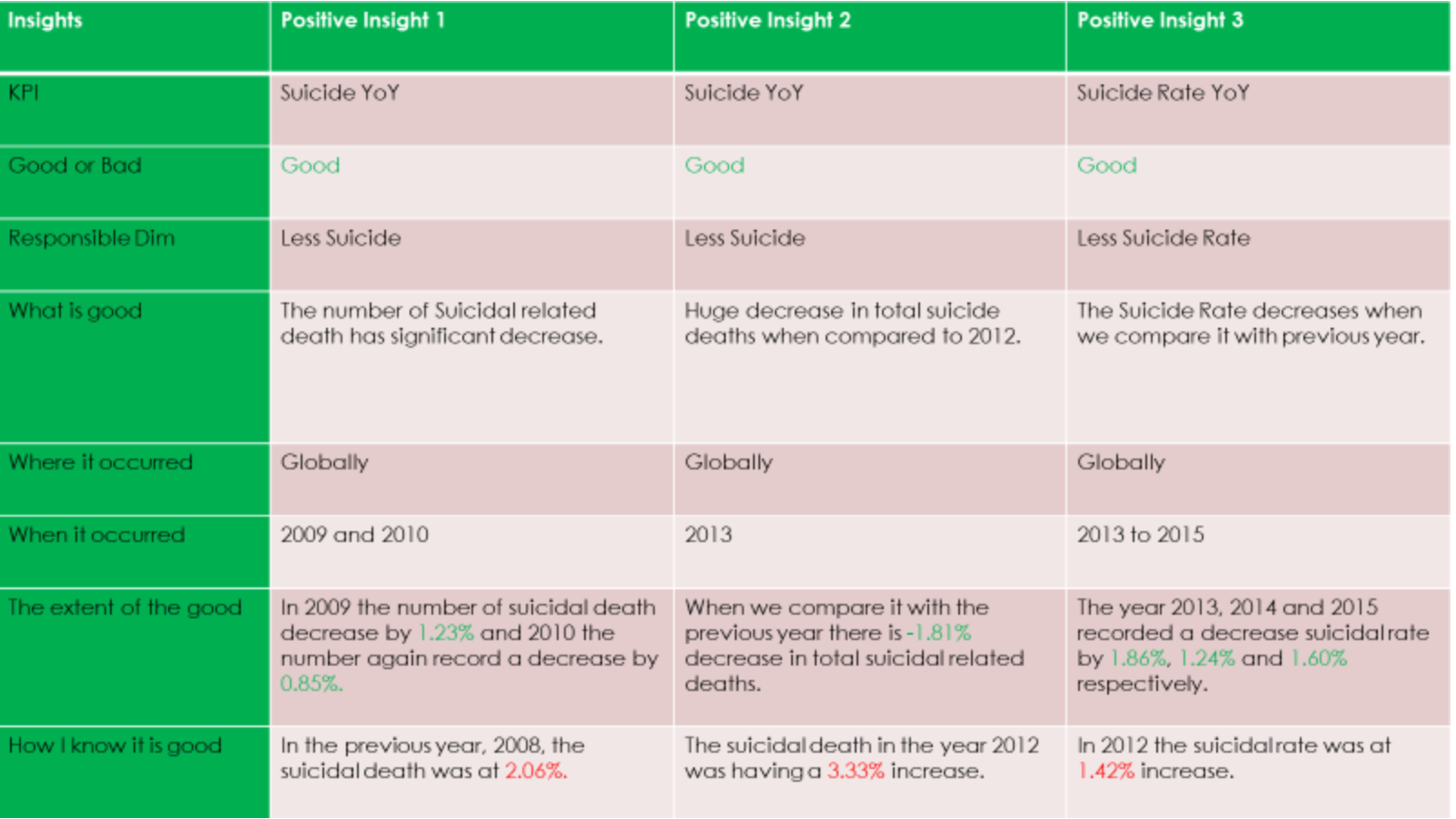Completion Date:
Project Overview
This project aims to show how Suicide is a silent killer and it needs a serious attention throughout the world. Despite a total global suicide count of 7 million over the period of 1985-2015, the suicide rate has been observed at 0.38%, revealing a complex interplay between suicide incidents and population dynamics. The year-on-year (YoY) changes further highlight intriguing patterns, with suicide YoY increasing by 2.18% while suicide rate YoY shows a contrasting decrease of -1.60%. This prompts the need for a comprehensive analysis to understand the underlying factors influencing global suicide trends, considering both absolute numbers and rates, in relation to population fluctuations. Such insights can contribute to the development of targeted interventions and policies aimed at reducing suicide rates and addressing the mental health challenges faced by diverse populations worldwide.
Role:
Problem Statement
The prevalence of suicide represents a critical global health challenge. According to the 2019 estimates provided by the World Health Organization (WHO), suicides accounted for over 700,000 deaths worldwide, equivalent to approximately 1.3% of the total reported deaths globally. This statistic underscores suicide as the 17th leading cause of death in 2019. In light of this distressing reality, the project, \"Global Suicide Trends: Analyzing Demographics and Generational Patterns (1985-2015),\" aims to comprehensively examine the demographic and generational factors contributing to this significant public health concern. By analyzing data over three decades, the study intends to unravel critical insights that can inform targeted interventions and mental health support strategies on a global scale.
Next Steps
Suggestions:
1. Tailored Interventions: Recognizing the higher suicide rates in Asia (2,657,579) and Europe (2,191,511), it is crucial to implement tailored interventions that specifically address the unique challenges prevalent in each region. Suicide prevention efforts should go beyond generic approaches and consider the cultural factors that significantly influence mental health perceptions and behaviors. Developing region-specific mental health awareness campaigns is imperative to foster understanding, reduce stigma, and encourage open dialogue surrounding mental health issues. By acknowledging and addressing the distinct challenges faced by communities in Asia and Europe, we can create more effective and culturally sensitive suicide prevention strategies, ultimately contributing to a reduction in regional suicide rates.
2. Generational-Specific Mental Health Programs: In response to the higher suicide rates among specific generations, particularly Boomers (2,279,783) and the Silent Generation (1,779,887), it is imperative to implement targeted mental health programs. These initiatives should be meticulously designed, taking into account the unique needs, pressures, and challenges experienced by each generation. Recognizing the distinct factors influencing mental health within different age groups will contribute to the effectiveness of these programs, fostering a more comprehensive approach to suicide prevention.
3. Gender-Sensitive Suicide Prevention Initiatives: The significant gender disparity in suicide rates, with 76.89% reported among men, necessitates the implementation of gender-sensitive suicide prevention initiatives. Tailoring mental health awareness campaigns, community support programs, and counseling services to specifically address the distinct challenges faced by men is essential. This approach acknowledges the societal stereotypes around masculinity and mental health, aiming to create an environment where individuals of all genders feel comfortable seeking help. By actively addressing this gender imbalance, we can work towards a more empathetic and effective approach to suicide prevention.
4. Population Decline Mitigation: Collaborating with public health agencies becomes crucial in addressing the alarming -9.40% population decline. To tackle this issue comprehensively, it is recommended to implement initiatives promoting mental well-being as an integral part of broader population health strategies. By intertwining mental health promotion with overarching public health efforts, we can create a more resilient and supportive environment, contributing to both individual and population-wide well-being.
Deployment
More Projects
Predicting Occupancy Rates in Dallas AirBNB
Embarking on an exploration of the Dallas Airbnb landscape from 2014 to 2023, this study seeks to sh... ... More






